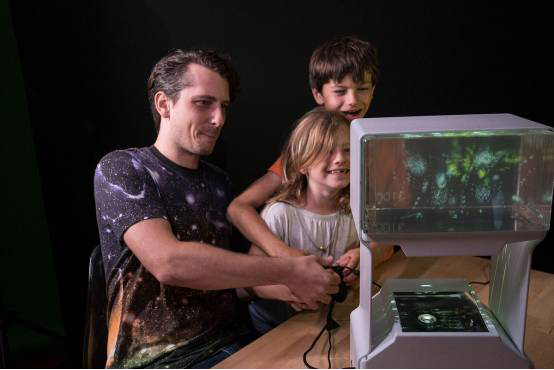
Tencent Digital (Compiler: Guti) The recent emergence of a new 3D experience device that makes us shine without the need for special space, headphones and helmets. Looking Glass, which is a team from Brooklyn and Hong Kong, launched this product called Volume and became "the world's first affordable 3D display device."
In the past two years, augmented reality and virtual reality technology have become very popular concepts. Both technologies can provide us with an immersive and augmented experience, respectively. However, both augmented reality and virtual reality require specialized hardware to achieve different results. We need to wear special glasses, helmets, and rely on smartphones or higher-profile PCs to experience these exciting effects. At the same time, the equipment required by these two technologies cannot share the experience with others and is limited to one person.
“Virtual Reality and Augmented Reality Technology So far, all 3D content can only be experienced by the user alone and must use helmets or glasses,†said Shawn Frayne, co-founder and CEO of the company. “And we are very happy to use Volume to let anyone share the 3D experience with others without the help of any device.â€
Volume is a 3D display and can be watched by many people. We can see 3D content from both the front and back with a 120-degree field of view. Volume uses a patented technology called Lightfolding, which is a new technology that enables 3D effects after guiding light.

The “volumetric†display is a technology that combines width, height, and depth. A flat, flat display screen displays light-emitting pixels in two dimensions, and is also enabled by color switches or transitions. People from multiple angles see the same content. Volume has 2 million 3D pixel points, which can also be called "voxels", and voxels can display 16.7 million colors.
Looking Glass's Lightfolding technology can suspend millions of light spots in three-dimensional space without the aid of a device, unlike the hologram images we were previously familiar with. Volume synchronizes pixels to 3D space, so it does not appear in the form of refraction, but is fixed in a specific location. At the same time, Volume is also very cheap in terms of price, and it can be called "the world's first affordable 3D display."
 The
The
The length, width and height of the Volume are respectively 53.8 x 19.3 x 26.9 cm, and the 14.9 x 25.6 x 19.3 cm display can be seen either from the front or from the back. The Volume, which weighs about 13 kilograms, can be connected to a PC or Mac via HDMI and is internally equipped with speakers and a touch screen.
At the same time, developers can download unified SDK development tools for free, and specifically develop some 2D or 3D-based applications or image content for Volume.
As a brand-new display technology, Volume does not need any additional equipment, so it has a broad prospect in education and entertainment. “And what's most exciting is that Volume content is quickly copied, anyone can create their own 3D impact, and there will be further development in the future.†Alex Hornstein, another founder and chief technology officer of Looking Glass Indicated.
Currently Volume has started accepting bookings for $999 and it is expected to begin shipping in April 2017.
Source: digitaltrends
.wxdigi { padding:20px 0; border-top: 1px dotted DBDBDB; } .wxdigi dt { display:inline; float:center; margin-right:17px; } .wxdigi dd strong { display:inline-block; padding-top :0px; color:414141; font-size:14px; } .wxdigi dd { font-size:14px; color:606060; }
Digital Resistive Touch Membrane Switch
Digital Resistive Touch Membrane Switch,Oval Type Membrane Switch,Two Circuit Layer Membrane Switch,Blue Background Membrane Switch
Dongguan Nanhuang Industry Co., Ltd , https://www.soushine-nanhuang.com
